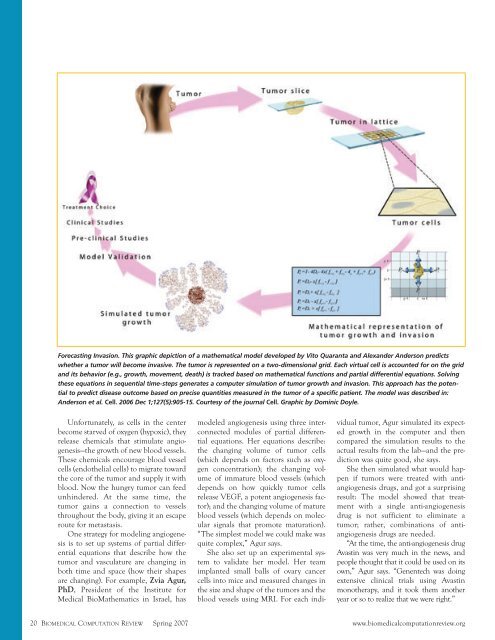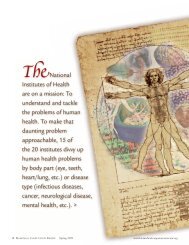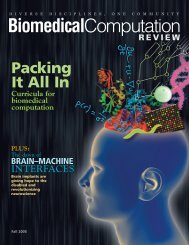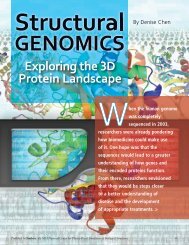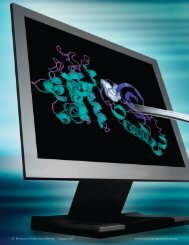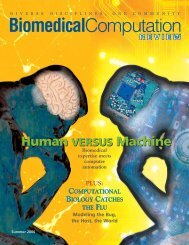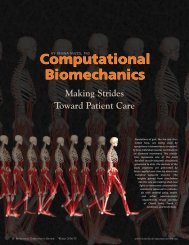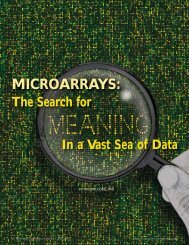Modeling Cancer Biology - Biomedical Computation Review
Modeling Cancer Biology - Biomedical Computation Review
Modeling Cancer Biology - Biomedical Computation Review
You also want an ePaper? Increase the reach of your titles
YUMPU automatically turns print PDFs into web optimized ePapers that Google loves.
Forecasting Invasion. This graphic depiction of a mathematical model developed by Vito Quaranta and Alexander Anderson predicts<br />
whether a tumor will become invasive. The tumor is represented on a two-dimensional grid. Each virtual cell is accounted for on the grid<br />
and its behavior (e.g., growth, movement, death) is tracked based on mathematical functions and partial differential equations. Solving<br />
these equations in sequential time-steps generates a computer simulation of tumor growth and invasion. This approach has the potential<br />
to predict disease outcome based on precise quantities measured in the tumor of a specific patient. The model was described in:<br />
Anderson et al. Cell. 2006 Dec 1;127(5):905-15. Courtesy of the journal Cell. Graphic by Dominic Doyle.<br />
Unfortunately, as cells in the center<br />
become starved of oxygen (hypoxic), they<br />
release chemicals that stimulate angiogenesis—the<br />
growth of new blood vessels.<br />
These chemicals encourage blood vessel<br />
cells (endothelial cells) to migrate toward<br />
the core of the tumor and supply it with<br />
blood. Now the hungry tumor can feed<br />
unhindered. At the same time, the<br />
tumor gains a connection to vessels<br />
throughout the body, giving it an escape<br />
route for metastasis.<br />
One strategy for modeling angiogenesis<br />
is to set up systems of partial differential<br />
equations that describe how the<br />
tumor and vasculature are changing in<br />
both time and space (how their shapes<br />
are changing). For example, Zvia Agur,<br />
PhD, President of the Institute for<br />
Medical BioMathematics in Israel, has<br />
modeled angiogenesis using three interconnected<br />
modules of partial differential<br />
equations. Her equations describe:<br />
the changing volume of tumor cells<br />
(which depends on factors such as oxygen<br />
concentration); the changing volume<br />
of immature blood vessels (which<br />
depends on how quickly tumor cells<br />
release VEGF, a potent angiogenesis factor);<br />
and the changing volume of mature<br />
blood vessels (which depends on molecular<br />
signals that promote maturation).<br />
“The simplest model we could make was<br />
quite complex,” Agur says.<br />
She also set up an experimental system<br />
to validate her model. Her team<br />
implanted small balls of ovary cancer<br />
cells into mice and measured changes in<br />
the size and shape of the tumors and the<br />
blood vessels using MRI. For each indi-<br />
vidual tumor, Agur simulated its expected<br />
growth in the computer and then<br />
compared the simulation results to the<br />
actual results from the lab—and the prediction<br />
was quite good, she says.<br />
She then simulated what would happen<br />
if tumors were treated with antiangiogenesis<br />
drugs, and got a surprising<br />
result: The model showed that treatment<br />
with a single anti-angiogenesis<br />
drug is not sufficient to eliminate a<br />
tumor; rather, combinations of antiangiogenesis<br />
drugs are needed.<br />
“At the time, the anti-angiogenesis drug<br />
Avastin was very much in the news, and<br />
people thought that it could be used on its<br />
own,” Agur says. “Genentech was doing<br />
extensive clinical trials using Avastin<br />
monotherapy, and it took them another<br />
year or so to realize that we were right.”<br />
20 BIOMEDICAL COMPUTATION REVIEW Spring 2007 www.biomedicalcomputationreview.org


